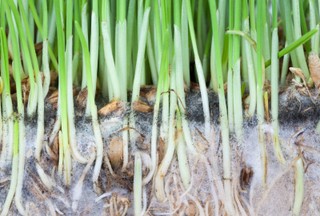Houseplant mold: Identify, remove, and prevent unwanted mold on indoor plants

White fuzzy mold isn’t any good on the cheese in your fridge, and it’s almost as frustrating to see in the containers of your plants. Especially if you’re growing herbs or other edible foods, but rest assured it’s easy to fix and can be prevented. Don’t worry, I think it’s probably safe to admit that at one time or another, even the most experienced gardeners have come face to face with mold growing on their houseplant soil!

What is the mold on your soil?
Mold is a type of fungus consisting of microscopic spores, or teeny tiny particles that are constantly floating around in the air. Unbeknownst to many, these mold spores exist everywhere and are on most surfaces.
When mold is present at low levels, under normal conditions, the amount found in the air isn’t typically a health concern.
However, when it begins to grow on the soil in your plants it may increase their susceptibility to root rot, causing damage. When found in higher levels it also decreases the air quality in your home impacting both humans and pets living in the space, negating the air-purifying benefits typically reaped from having houseplants. It can also trigger respiratory issues for people with mold allergies.
As an aside, while the terms mold and mildew are used interchangeably, there is a notable difference between the two. Scientifically, mildew refers to the type of fungus that grows on plants such as powdery mildew that may grow on plants in your vegetable garden. Commonly mildew is used to describe fungi that grow on the surface of items in a flat pattern. Mold often has a roundish shape and rises upward off the surface as it grows.
How does this mold develop
Mold growth occurs on almost any surface and isn’t an indicator of cleanliness. When airborne spores land on a surface and have given the right conditions, i.e. a food source, moisture, warmth and oxygen, they begin to regenerate and grow.
Unfortunately, the potting soil you use for your container plants, especially when grown indoors, is a prime location. The spores feed on organic material found in the potting mix. Your ambient household temperature and the moisture you give your plants can act as a catalyst, causing the furry stuff to take up residence and begin multiplying.

Types of mold
As I said before, mold is everywhere. There are hundreds of different types that occur both outside and inside your home, depending upon the fungal spores present. It’s important to know what type of mold you are dealing with to gain an understanding if it is dangerous or not.
The molds with associated health risks can be divided into three types:
- Allergenic: this type may cause allergic reactions such as asthma attacks in susceptible individuals.
- Pathogenic: this type may cause infections or other health problems in people with compromised immune systems or acute illnesses.
- Toxigenic: this type is what is known as “toxic mold” and can lead to dangerous or even deadly health conditions in anyone regardless of their health.
Common types
For simplicity’s sake, the common types of molds are classified by their color. But be aware different species of molds can grow as the same color
Green Molds - One of the most commonly found molds within homes, green mold is usually found growing on foods such as citrus fruits and bread.
White Molds - The other mold commonly found in homes, white mold is typically found growing on the soil of your plants or on porous, paper, pulp or wood-based surfaces. It is probably a harmless saprophytic fungus, an organism that feeds on organic matter to help break it down.
Red Molds - Actually, red mold isn’t mold at all, but instead a type of yeast. It typically accompanies other types of dark-colored molds and inhabits building materials like vinyl flooring, walls, carpets, and wall paneling.
Black Molds - Many people mistakenly think all black mold is dangerous. In reality, black molds are most commonly found growing outside growing around damp, dusty areas, soil, and plants and pose a low risk to humans.
Toxic molds can come in many different colors, not just black, and not all black molds are toxic. The CDC is careful to explain that “toxic” is an inaccurate descriptor. It’s not the mold itself that is toxic or poisonous, but rather certain types of molds, Stachybotrys chartarum especially, produce toxins that present hazards.

The enthusiast's guide to herbs
We’re proud to present our new e-book, The Enthusiast’s Guide to Herbs! Learn everything you need to know about growing and caring for herbs indoors, including in-depth info cards for the 35 most commonly grown herbs.
Click the link below to find out more!
Identifying the mold
One of the first steps to follow when you see any kind of mold on the soil of your indoor houseplants is to identify what types it is, so you can properly remediate the problem.
White Mold: appears as downy, fuzzy growth on the surface of the soil. May look cottony in nature. As mentioned above, this mold is typically a saprophytic fungus and poses little harm to humans or your plants. This fungus colonizes the soil surface when conditions are damp and ventilation is limited.
Sooty Mold: appears as black or dark green sooty looking patches on the base of the plant and on the soil surface. The presence of sooty mold indicates your houseplant is infected with scale, tiny insects that feed on the sap of your plant and then excrete what is known as honeydew. Sooty mold doesn’t directly harm plants but if left to reproduce it can inhibit photosynthesis.
Grey Mold: caused when the airborne spores of the fungus Botrytis land on open wounds of the plant or diseased/dying tissue. Grey mold appears as dusty gray spores and is generally found near the soil surface or in the densest areas of the plant’s foliage. Infected areas on the plant enlarge quickly, causing tissue collapse; if left untreated grey mold can kill the entire plant.
Powdery Mildew: presents as a white powdery film on the leaves and stems of your plants that looks similar to a dusting of flour. Over time it may darken in appearance to a grey color and spread to the soil. Powdery mildew impairs photosynthesis, stunting plant growth and can kill the plant if left untreated.

How to get rid of mold
Treatment methods vary slightly depending on the type of mold you have growing on your house plant soil.
Removing white mold
If you notice white fuzzy mold on your indoor plants it’s best if you get rid of it as quickly as you can, even though it is likely harmless.
- Before trying anything else, take the plant outside and let it sit where it can bask in natural sunlight and gets plenty of air movement. A full day outside is great, a couple is even better as long as you bring it indoors at night if the temperature drops too low. The sun and air may be enough to clear up the mold for you.
- If putting your plant outside doesn’t work, or isn’t feasible you’ll need to tackle the removal yourself. Wearing a mask, carefully scrape the mold off the top of the soil surface using a spoon, putty knife, or something similar. Dispose of the mold in a zip-top bag in the trash.
- Using a soft clean cloth dampened with a diluted dish detergent solution, wipe down the plant to remove any mold growing on the foliage. This helps to prevent reinfection of the potting soil.
- After removing the mold manually and cleaning the plant’s leaves, you can opt to apply a fungicide to treat the mold that is beneath the surface, down in the root zone. There are many options available, including a variety of organic formulations. Make sure to apply at the rate recommended on the product label.
Removing sooty mold
First things first, you need to treat the insect infestation in your houseplants or the sooty mold will continue to be problematic.
If the population of insects is low you can manually pick them off with your fingers or a pair of sterilized tweezers, disposing of them afterward. You can also dab them with an alcohol-soaked cotton swab. If the population is heavier apply insecticidal soap or horticultural oil to treat the plant.
Once the scale has been treated you can wipe the sooty mold off your plant’s foliage with a clean, damp cloth. A dilute soap solution may be used if the sooty mold is persistent. Then place your plant in the kitchen sink or bathtub and gently rinse all of the leaves.
Removing grey mold
Botrytis can harbor in the soil, so it’s important to make sure it is treated thoroughly to prevent reinfection.
- Isolate the plant from your other houseplants and remove any infected or diseased plant tissue using sterilized scissors or a razor blade. Dispose of tissue in the trash.
- Apply a biological or copper-based fungicide to the plant following the manufacturer’s directions on the product label. Make sure to thoroughly soak the soil as well. Reapply the chosen fungicide every 1-3 weeks or as needed until the fungal pressure has completely subsided.
Removing powdery mildew
Different strains of the fungus causing powdery mildew are responsible for infection of different houseplants. For example, the fungus that causes it in African violets is different than the fungus that causes it in your jade plant. This means transmission from one plant to another is low but it’s still imperative to treat it before it severely damages the infected plant.
- Remove any infected or diseased plant tissue using sterilized scissors or a razor blade. Dispose of tissue in the trash.
- Spray infected plants with bicarbonate solution (1 teaspoon baking soda in a quart of water) or a sulfur-based fungicide according to the label directions.
Remediating severe mold problems
If the problem is severe or widespread regardless of the type of mold, repotting your plants may be necessary. Repot them into clean, sterilized containers (soak plastic pots in a solution of 9 parts water and 1 part bleach, rinse thoroughly with clean water) with fresh potting mix. If you want to reuse the contaminated potting mix you can sterilize the soil to kill any pathogens in it.
How to prevent mold from growing
One of the best ways to deal with mold is to simply prevent it from growing, by following some of these general care practices.
- Do not overwater - Without a doubt, overwatering is the leading culprit of mold growth. Let the top layer of soil dry out before watering your plants again: the top 2” of larger pots should be allowed to dry out before watering; the top ½ to 1-inch in smaller containers.
- Reduce humidity - If you live in an area with high humidity, your houseplants’ soil may be predisposed to a mold problem. Use a dehumidifier to reduce the relative humidity around your plants.
- Give them light - Make sure your houseplants are getting enough light. Natural sunlight is best, but supplemented light helps as well. If the weather is nice periodically put your plants outside to get sun, making sure they don’t get scorched.
- Good drainage - Make sure the containers have drainage holes, don’t create a drainage layer when potting up your plants (this is an outdated practice), and don’t let plants sit in a saucer with standing water.
- Good air circulation - Arrange plants so there is adequate space for the air to circulate between them. It also helps the soil dry out more quickly after watering.
- Housekeeping - Remove dead leaves from plants as well as any debris that accumulates on the soil surface to prevent fungal growth.
- Inspect any new plants coming into your home for mold or any other signs of disease, so it isn’t introduced and spread to your existing plants.
- Natural antifungals - You can sprinkle cinnamon, baking soda, apple cider vinegar on the soil surface to naturally prevent growth. All three items are safe to use in a small amount and won’t pose any risk to your plants.
Conclusion
It’s not uncommon for mold to pop up on the soil surface of your houseplants. While in most cases the fuzzy, white mold isn’t anything to worry about, it’s still a good idea to get rid of it and then try to prevent it from popping up again. Mold prevention methods include proper watering, plenty of light, and good air circulation.

Join our email club—get printable info cards free!
Sign up to receive our newsletter and get access to 10 printable plant info cards from our e-book for free. Also receive:
- $4 discount code for our Guide to Herbs e-book
- Semi-weekly plant inspiration & bite-size tips and tricks
